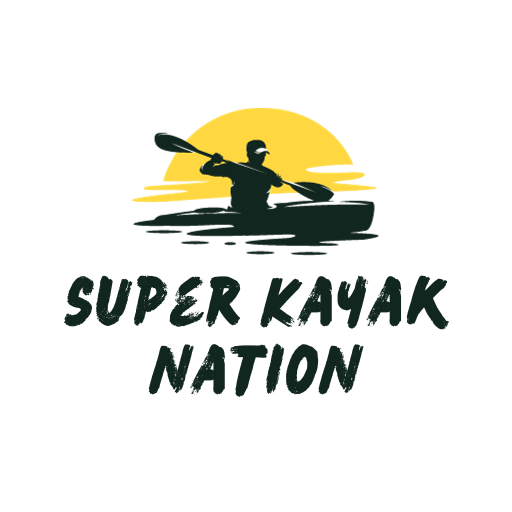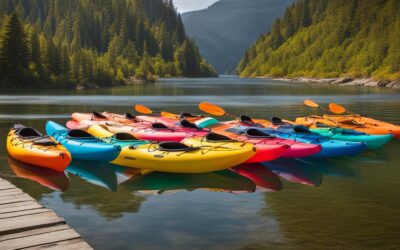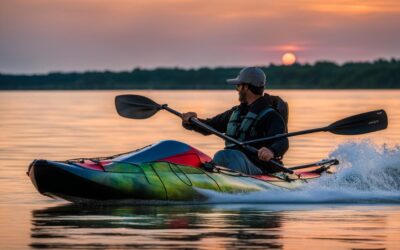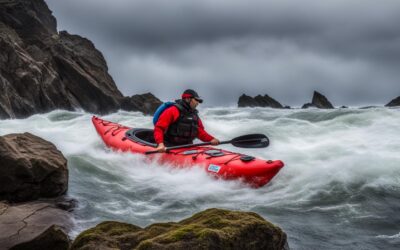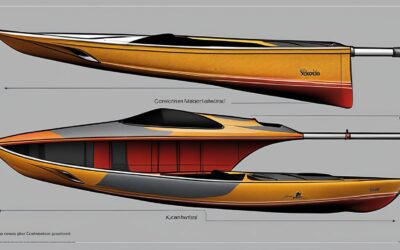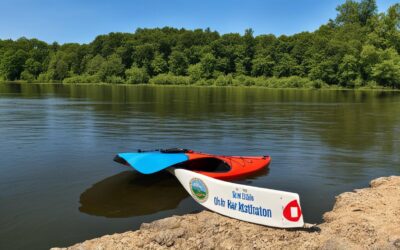Are you curious about the difference between a kayak and a canoe? These two watercraft varieties have been used for centuries, but they each have their own unique characteristics that set them apart. In this article, we will delve into the specific design, paddling position, and paddle type differences between kayaks and canoes. So, if you’ve ever wondered which one is right for you, keep reading to find out!
Key Takeaways:
- Kayaks have a closed deck design, while canoes have an open-top deck.
- Canoe rowers can sit or kneel, while kayak rowers sit inside with their legs stretched out.
- Kayaks use a double-bladed paddle, while canoes use a single-bladed paddle.
- Kayaks are known for their agility and speed, while canoes provide stability and comfort.
- Kayaks are easier to transport due to their smaller size and weight.
Design Differences
When comparing kayaks and canoes, one of the most noticeable differences is their design. Canoes feature an open-top deck, providing a spacious area where the rower can sit or kneel. This open design allows for easy entry and exit from the watercraft and offers a sense of freedom. On the other hand, kayaks have a closed deck, where the rower sits inside the watercraft with their legs stretched out in front of them. This closed design provides more protection from the elements and a greater sense of security.
Additionally, canoes typically have higher sides compared to kayaks. The raised sides of canoes help prevent water from splashing into the watercraft, keeping the rower and their belongings relatively dry. In contrast, kayaks have lower sides, which makes them closer to the water. This lower profile enhances the kayak’s stability and maneuverability, making it an ideal choice for activities such as whitewater kayaking or navigating narrow waterways.
Overall, the design differences between kayaks and canoes contribute to their unique characteristics and suitability for various water activities. While canoes provide a spacious and open experience, kayaks offer a more enclosed and streamlined design.
Comparing Design Differences
| Canoes | Kayaks | |
|---|---|---|
| Type of Deck | Open-top | Closed |
| Rowing Position | Sitting or Kneeling | Sitting with legs stretched out |
| Side Height | Higher | Lower |
| Main Features | Spaciousness, easy entry and exit | Protection, stability, maneuverability |
Kayak and Canoe Paddling Position Differences
In the comparison between kayaks and canoes, one of the key differences lies in the paddling position. The rower’s position in each watercraft affects not only their comfort but also the efficiency and maneuverability of their strokes.
In a canoe, you have the option to either sit or kneel while paddling. This flexibility allows for a more relaxed and leisurely experience, perfect for enjoying calm waters or scenic explorations. The rower uses a single-bladed paddle, also known as a canoe paddle, to propel the watercraft forward. The single blade provides a rhythmic and graceful stroke, requiring the rower to alternate sides with each paddle.
On the other hand, kayaks offer a seated position with the rower’s legs stretched out in front. This allows for a more stable and balanced paddling experience, especially when tackling rougher waters. The kayaker uses a double-bladed paddle, known as a kayak paddle, to execute powerful and efficient strokes. With a blade on each end, the rower can paddle on both sides simultaneously, providing greater speed and control.
Which Paddling Position is Right for You?
The choice between a canoe and a kayak largely depends on your personal preferences and paddling goals. If you seek a more relaxed and leisurely outing, where you can enjoy the scenery and take your time, a canoe with its versatile paddling position may be the better option for you. Canoes also tend to be more accommodating for multiple passengers and larger cargo loads.
However, if you prefer a faster and more exhilarating experience on the water, with the ability to navigate swiftly and tackle challenging conditions, a kayak’s seated position with a double-bladed paddle offers enhanced speed, agility, and control. Additionally, kayaks are well-suited for activities such as fishing, touring, and even whitewater adventures, where maneuverability is essential.
Ultimately, whether you choose a kayak or a canoe, the paddling position plays a crucial role in your overall experience and performance on the water. Consider your preferences, the type of activity you plan to engage in, and the desired level of comfort and control before making your decision.
Below is a comparison table highlighting the key differences between the paddling positions in kayaks and canoes:
| Canoe | Kayak | |
|---|---|---|
| Paddling Position | Sitting or Kneeling | Sitting with Legs Stretched Out |
| Paddle Type | Single-Bladed | Double-Bladed |
| Maneuverability | Good, requires alternating strokes | Excellent, simultaneous strokes on both sides |
| Speed | Relaxed and leisurely | Fast and agile |
| Comfort | Flexible sitting or kneeling position | Stable, balanced seated position |
Paddle Type Differences
When comparing kayaks and canoes, one notable difference is the type of paddle used. The choice of paddle can greatly affect the performance and maneuverability of the watercraft. Kayaks require a double-bladed paddle, while canoes use a single-bladed paddle.
Owning a kayak means using a double-bladed paddle, which has two blades at both ends. This allows for a more efficient and smoother paddling experience. The dual blades enable kayakers to paddle on both sides, creating a symmetry that propels the kayak forward with greater ease. The double-bladed paddle also offers more control and agility, making it ideal for navigating through narrow waterways and performing quick maneuvers.
On the other hand, canoes are equipped with a single-bladed paddle. The single-bladed paddle is typically longer and wider, with a curved blade on one end. Canoeists use a different paddling technique, mainly relying on a simple forward stroke and a J-stroke to steer the canoe. While it may not have the speed and efficiency of a double-bladed paddle, the single-bladed paddle offers a different kind of experience, allowing canoeists to enjoy a more leisurely and relaxed pace on the water.
Overall, the choice between a double-bladed paddle for kayaks and a single-bladed paddle for canoes depends on personal preference and the desired experience on the water. Each paddle type has its own advantages and is suited for different activities, whether it’s exploring calm lakes and rivers or engaging in fast-paced water sports.
Comfort and Versatility
When choosing between a kayak and a canoe, comfort and versatility are important factors to consider. Each type of watercraft offers unique advantages, catering to different preferences and activities.
Comfort
If you prioritize comfort during your water excursions, a canoe might be the better option for you. Canoes are known for their spacious design, providing ample seating and legroom. This makes them ideal for leisurely activities such as fishing or exploring calm waters. Canoes also have higher sides, which offer more protection from splashing water, keeping you and your gear dry.
On the other hand, kayaks offer a snug and secure seating position. With the rower sitting inside the closed deck, kayaks provide a more ergonomic fit, allowing for better control and balance. This can be beneficial for more adventurous activities like whitewater rafting or navigating rougher waters. However, if you prefer a more relaxed and spacious paddling experience, a canoe may be a more comfortable choice.
Versatility
When it comes to versatility, kayaks excel in their agility and maneuverability. The closed deck design and streamlined shape of a kayak allow for quicker and more precise movements. This makes them ideal for various sports and recreational activities that require quick turns and navigation through tight spaces. Whether you’re exploring narrow rivers, venturing into sea caves, or riding ocean waves, a kayak offers the versatility to handle different environments.
On the other hand, canoes are known for their stability and carrying capacity. Canoes have a wider and more spacious hull, making them suitable for carrying larger loads or accommodating multiple passengers. This makes canoes a popular choice for multi-day camping trips or family outings where you need to transport gear and supplies. Canoes provide a stable platform for activities such as picnicking, wildlife watching, or simply enjoying a leisurely paddle on calm waters.
Ultimately, the choice between a kayak and a canoe depends on your personal preferences and the specific activities you plan to engage in. Consider factors such as comfort, versatility, and the type of experience you want to have on the water. Whether you prioritize speed and maneuverability or opt for stability and spaciousness, both kayaks and canoes offer unique advantages that can enhance your enjoyment of water-based adventures.
kayak and canoe comparison: Performance
When it comes to performance, kayaks and canoes have distinct characteristics that cater to different needs and preferences. The streamlined shape, lighter weight, and double-bladed paddle of a kayak provide excellent maneuverability and speed. Kayaks are designed for agility, making them ideal for sports and recreational activities that require quick turns and swift movements.
On the other hand, canoes prioritize stability and carrying capacity. With their wider hull and higher sides, canoes offer a more stable ride, making them less likely to capsize. Canoes are better suited for calm waters and can accommodate larger loads, making them perfect for multi-day camping trips and fishing excursions where carrying equipment and supplies is essential.
To illustrate the differences in performance between kayaks and canoes, refer to the table below:
| Performance Aspect | Kayaks | Canoes |
|---|---|---|
| Maneuverability | Excellent | Good |
| Speed | Fast | Moderate |
| Stability | Fair | High |
| Carrying Capacity | Low to Moderate | High |
As seen in the table, kayaks offer superior maneuverability and speed, but canoes excel in stability and carrying capacity. The choice between the two ultimately depends on your specific requirements and intended use of the watercraft.
Ultimately, understanding the performance differences between kayaks and canoes allows you to make an informed decision based on your desired water activities. Whether you prioritize speed and agility or stability and carrying capacity, there is a suitable watercraft option for you.
Ease of Transportation
When it comes to ease of transportation, there are some differences between kayaks and canoes. Kayaks tend to be smaller and lighter, making them more manageable to carry and transport. Whether you’re loading it onto the roof of your car or carrying it to the water’s edge, the compact size and lighter weight of a kayak can make the process a little easier.
On the other hand, canoes, especially traditional ones, are generally larger and bulkier. While there are inflatable canoe options available that offer greater portability, they still require more effort to transport compared to kayaks. Their size and weight can make it more challenging to maneuver them on land and load them onto a vehicle.
Both kayaks and canoes have their own advantages and challenges when it comes to ease of transportation. However, it’s worth noting that advancements in technology, such as lightweight materials and collapsible designs, have made both types of watercraft more convenient to transport than ever before.
FAQ
What are the main differences between a kayak and a canoe?
The main differences between a kayak and a canoe include their design, paddling position, and paddle type.
What is the design difference between a kayak and a canoe?
Canoes have an open-top deck, while kayaks have a closed deck. Canoes have higher sides, providing more protection from splashing water, while kayaks are lower and closer to the water.
How does the paddling position differ between a kayak and a canoe?
In a canoe, the rower can sit or kneel and uses a single-bladed paddle. In a kayak, the rower sits inside with their legs stretched out and uses a double-bladed paddle.
What are the differences in paddle type between a kayak and a canoe?
Kayaks require a double-bladed paddle, while canoes use a single-bladed paddle.
What factors should I consider when choosing between a kayak and a canoe?
Consider comfort and versatility. Kayaks are more agile and faster, great for sports and recreational activities. Canoes are more stable and spacious, providing a comfortable ride for leisurely activities and accommodating more passengers.
How do kayaks and canoes differ in terms of performance?
Kayaks are more nimble and faster, while canoes are more stable and harder to capsize. Kayaks are better suited for quick maneuvers and calm waters, while canoes are ideal for multi-day camping trips and fishing excursions.
How do kayaks and canoes differ in terms of ease of transportation?
Kayaks are generally smaller and lighter, making them easier to carry and transport. Canoes tend to be bulkier and more challenging to transport, although inflatable models have made them more portable.
